
* The Americans were laggards in the development of turbojet engines in World War II, initially leveraging off British technology. As as starter exercise, the US developed the Bell "XP-59 Airacomet" fighter; although a limited batch was built, it was inadequate for operational service, and served primarily as a training exercise. Bell also developed prototypes of a larger long-range jet fighter along the lines of the XP-59, designated the "XP-83", but it never went beyond prototypes. This document provides a history and description of the XP-59 and XP-83 -- as well as of three "mixed-power" fighters, using both prop and jet propulsion, including the Convair "XP-81", the Ryan "FR-1 Fireball", and Curtiss "XF15C-1".
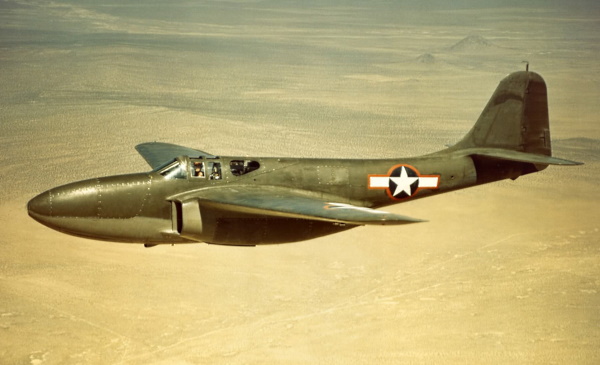
* The British were among the pioneers of jet engine design, thanks to the work of Frank Whittle -- a British Royal Air Force (RAF) pilot with ideas for a turbojet engine. Working as part of a firm named "Power Jets", Whittle was running ground tests of a prototype engine from 1937, leading to the flight of a demonstrator aircraft, the "Gloster E.28/39", in 1941.
The E.28/39 would lead to the Gloster "Meteor", Britain's first jet fighter. Trials of the demonstrator were observed during 1941 by Major General Henry H. "Hap" Arnold, commander of the US Army Air Forces (USAAF). Arnold obtained plans for the Power Jets W.1 engine that drove the E.28/39, and had one flown to the USA -- along with a handful of Power Jets engineers, and plans for the more powerful "W.2B/23" engine. Arnold arranged for General Electric to produce an American version of that engine, to be designated "GE I-A", and for the Bell Aircraft Company to build an aircraft powered by it. Bell wasn't too heavily committed to the war effort at the time, having some resources to spare, and its plant in Rochester, New York, was not too far from the GE plant in Schenectady. The aircraft was to be designated "P-59", adopting the designation of a canceled Bell aircraft project as a security cover; three "XP-59" prototypes were to be built.
Construction of the prototypes began in early January 1942, with the USAAF also ordering 13 "YP-59A" evaluation machines in March. In September 1942, the first XP-59A was shipped off by train from the Bell plant in Rochester, New York, to Muroc Army Air Field (now Edwards Air Force Base) in California for trials; it was disguised with a fake propeller for ground testing. While Bell test pilot Robert Stanley was performing high-speed taxi trials on 1 October, the XP-59A hopped up in the air -- though the official first flight was the next day, 2 October, with USAAF Colonel Laurence Cragie at the controls.
The XP-59A was made largely of aircraft aluminum, though with fabric-covered flight-control surfaces. It had mid-mounted straight wings, and a conventional tail assembly, with a mid-mounted tailplane. Flight controls were also conventional, including one-piece flaps, ailerons, elevators, rudder, and trim tabs. It was powered by twin GE I-A centrifugal-flow turbojets with a modest 6.23 kN (635 kgp / 1,400 lbf) pounds thrust each, in nacelles on the lower sides of the fuselage -- the tailplane was mounted up to keep it out of the jet exhaust. The XP-59A had tricycle landing gear, all with single wheels, the main gear retracting inward from the wings towards the fuselage, the nose gear retracting backwards. The cockpit was pressurized, with the canopy hinging to the right side.
The second XP-59A took to the air in February 1943, with the third following in April. Trials were not entirely satisfactory, mostly due to engine problems: Bell engineers had designed the aircraft around an engine wasn't available at the time -- and to not much surprise with such a new technology, engine development was not smooth, the GE1 engine proving unreliable and not up to expected power ratings. The aircraft also had poor roll stability. Famous test pilot Chuck Yeager flew the machine and didn't like the performance, or lack thereof, but enjoyed its smooth flight.
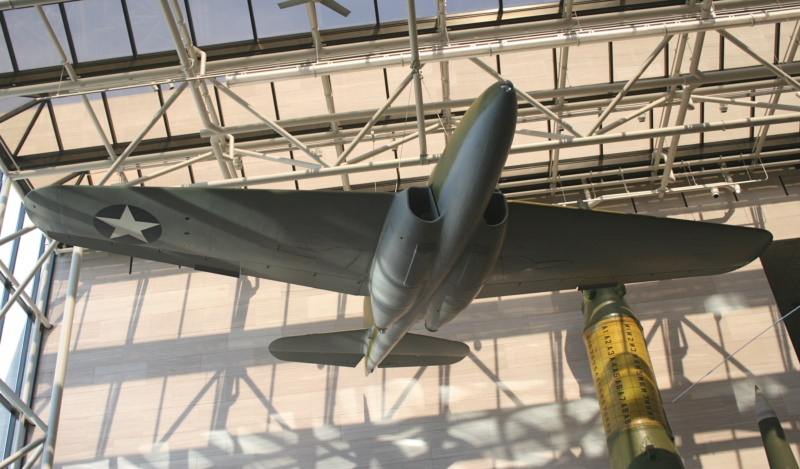
The first service-test YP-59A was delivered in June 1943. The YP-49A had improved GE I-16 turbojet engines with 7.34 kN (750 kgp / 1,650 lbf) thrust each, and also featured a rear-sliding canopy. The new engines resulted in only a slight improvement in performance, and they weren't more reliable. One of the YP-59As was traded to the RAF for a Gloster Meteor; the British evaluated the American machine, and were unimpressed. Indeed, it was not comparable in performance to firstline American piston-engine fighters like the P-51 Mustang. Two YP-59As were delivered to the US Navy, which evaluated them, supposedly under the designation of "YF2L-1" -- but the Navy also gave them a thumbs-down.
___________________________________________________________________
BELL P-59A AIRCOMET:
___________________________________________________________________
wingspan:
13.87 meters (45 feet 6 inches)
wing area:
35.9 sq_meters (386 square feet)
length:
11.84 meters (38 feet 10 inches)
height:
3.76 meters (12 feet 4 inches)
empty weight:
3,704 kilograms (8,165 pounds)
operating weight:
5,010 kilograms (11,040 pounds)
MTO weight:
6,215 kilograms (13,700 pounds)
max speed at altitude:
665 KPH (413 MPH / 359 KT)
service ceiling:
14,100 meters (46,200 feet)
range:
605 kilometers (375 miles / 325 NMI)
___________________________________________________________________
Even before delivery of the YP-59As in June 1943, the USAAF ordered 80 production machines, designated "P-59A" and named "Airacomet" -- following in the steps of earlier Bell fighters, including the "Airacuda" and "Airacobra". Only 20 P-59As were actually built, along with 30 P-59Bs. The P-59B only differed from the P-59A in having additional fuel tankage.
Early production machines were powered by J31-GE-3 engines, these being equivalent to the I-16. The last few were powered by J31-GE-5 turbojets with 8.9 kN (910 kgp / 2,000 lbf) thrust each. They were armed, with three 12.7-millimeter (0.50-caliber) Browning M2 machine guns and a single 37-millimeter T4 cannon, all in the nose. It appears that some of the YP-59As were armed as well, some with the originally-planned armament of three 37-millimeter cannon. They could carry a drop tank under each wing, and it seems could, at least in principle, carry bombs or unguided rockets. They replaced the rounded-off tip of the tailfin, and the rounded-off wingtips, with squared-off tips -- providing a distinctive recognition feature.
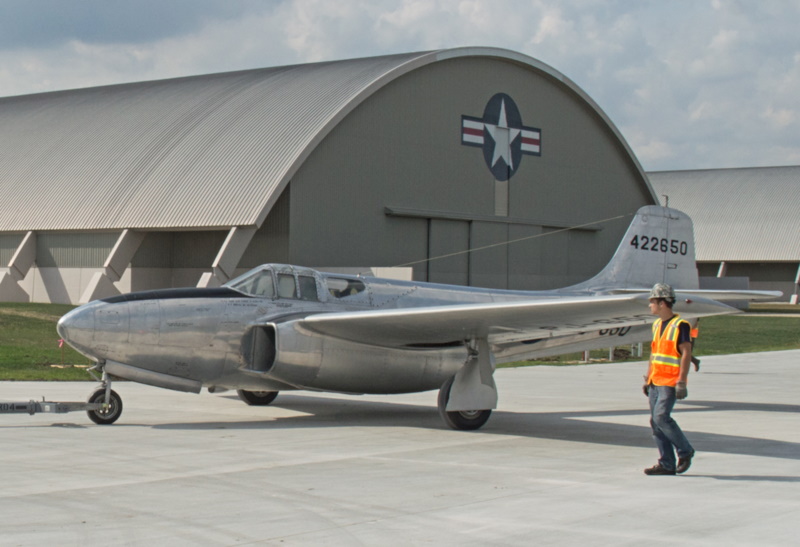
They were delivered in late 1944 and early 1945. The only real rationale for obtaining the production machines was to provide the USAAF with experience in dealing with jet-powered aircraft. Some were used as drone controllers, with an open cockpit in the nose for the drone handler; it seems the open cockpit was on a number of aircraft, in some cases apparently being used for joyrides. All the Airacomets were quickly retired after the war, with most of them scrapped. A few survive as museum displays; rumor has it one is being restored to flight condition.
BACK_TO_TOP* In July 1944, the USAAF awarded Bell a contract for a long-range jet escort fighter, with two prototypes ordered. Working from their "Model 40" interceptor concept, Bell developed the "XP-83", with the first prototype performing its initial flight on 25 February 1945, with Jack Woolams -- Bell's chief test pilot -- at the controls.
As it emerged, the XP-83 was more or less a scaled-up version of the P-59, made mostly with aircraft aluminum alloy, and with the same general configuration: mid-mounted straight tapered wing; conventional tail assembly, with the tailplane mounted above the fuselage topline; conventional flight controls; jet engines in nacelles against the lower fuselage; and tricycle landing gear, same configuration as with the P-59. Flaps were electrically-actuated, landing gear was hydraulically-actuated. It noticeably differed in having a rear-sliding bubble canopy. The cockpit was pressurized.
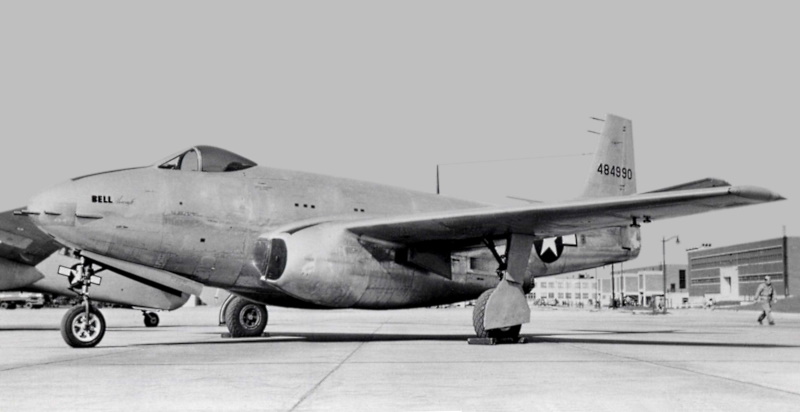
The XP-83 was powered by two General Electric J33-GE-5 centrifugal-flow turbojets with 17.8 kN (1,815 kgp / 4,000 lbf) thrust each. To achieve long range with the inefficient turbojets at the time, it had fuel tanks in the fuselage with a total capacity of 4,350 liters (1,150 US gallons); it could also carry a 950-liter (250 US gallon) drop tank under each wing. It was armed with six Browning M2 12.7 millimeter (0.50 caliber) machine guns in the nose.
___________________________________________________________________
BELL XP-83 (FIRST PROTOTYPE):
___________________________________________________________________
wingspan:
16.15 meters (53 feet)
wing area:
40 sq_meters (431 sq_feet)
length:
13.67 meters (44 feet 10 inches)
height:
4.65 meters (15 feet 3 inches)
empty weight:
6,398 kilograms (14,105 pounds)
operating weight:
10,927 kilograms (24,090 pounds)
max takeoff weight:
12,474 kilograms (27,500 pounds)
max speed at altitude:
840 KPH (522 MPH / 455 KT)
service ceiling:
14,000 meters (45,000 feet)
range:
2,780 kilometers (1,730 miles / 1,500 NMI)
range with drop tanks:
3,300 kilometers (2,050 miles / 1,780 NMI)
___________________________________________________________________
The first prototype suffered from yaw instability, which had been suggested by wind-tunnel tests; it was also underpowered. The lack of power meant a long take-off run -- and landings weren't much better, since the aircraft was sleek and didn't have dive brakes. In addition, the exhaust heat from the engines tended to warp the tail, with fire hoses used to pour water on the tail during run-up to keep it cool.

The second prototype flew on 19 October 1945. It featured a taller tailfin, an aileron boost system, and the engines toed out to keep the exhaust away from the tail. It was armed with six 15.2-millimeter (0.60-caliber) machine guns, with other gun fits contemplated. Aside from range, the XP-83 was inferior to the Lockheed P-80 Shooting Star, and so the XP-83 project was canceled in 1947.
The first prototype was used in 1946 as a ramjet test-bed with an engineer's station located in the fuselage behind the pilot, accessed via a hatch in the belly. On 14 September 1946, one of the ramjets caught fire, forcing pilot "Slick" Goodlin and engineer Charles Fay, to bail out. The second prototype was scrapped in 1947. Bell went nowhere with jet fighters, but had a big future with helicopters.
BACK_TO_TOP* The limitations of the early turbojet engines suggested to aircraft designers that it might be best to have aircraft with both prop and jet engines, using the prop as the primary means of propulsion and the jet for boost power. The USA according developed a series of "mixed-power" fighters.
In early 1944, the USAAF awarded a contract to the Consolidated-Vultee Aircraft Company -- the product of a 1943 merger, the name evolving to the more convenient "Convair" -- to build two examples of a mixed-power fighter, to be powered by a GE TG-100 turboprop (later designated XT31) in the nose and a GE / Allison J33-GE-5 centrifugal-flow turbojet, to provide 16.7 kN (1,700 kgp / 3,750 lbf) thrust in maturity, in the rear fuselage. Initial flight of the first "XP-81" was from Muroc on 11 February 1945.
As it emerged, the XP-81 was a low-wing all-metal fighter with tricycle retractable landing gear, conventional tail configuration and control-surface arrangement, and a pressurized cockpit under a bubble canopy. Since the TG-100 wasn't ready to fly at the time, the prototype was fitted with a V-1650-7 12-cylinder water-cooled vee engine from a P-51D Mustang instead, driving a four-bladed paddle prop. The initial flight went well, except for "snaking" due to the long forward fuselage; the tailfin was enlarged and a ventral fin was added in response.
The USAAF had ordered 13 YP-81 pre-production machines, these machines to be fitted with the GE TG-110 (XT41) turboprop engine. The wing would be moved back 25 centimeters (10 inches), and unlike the prototypes, these machines were to be armed -- either with six 12.7-millimeter Brownings, or six 20-millimeter cannon. They would also be capable of carrying underwing stores. However, the approach of the end of the war meant there was no longer any immediate need for the P-81, with the order for the YP-81s canceled with the surrender of Japan.
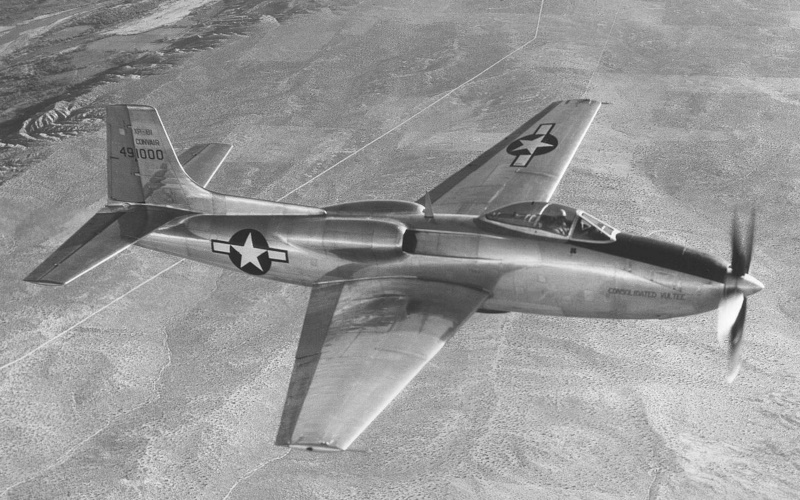
The first prototype was returned to Vultee to be fitted with the TG-100 turboprop, leading to the first flight of a US turboprop-powered aircraft on 21 December 1945. Unfortunately, the TG-100 proved disappointing: it was designed to deliver 1,715 kN (2,300 HP), but only delivered 1,045 kW (1,400 HP). It was no more powerful than the Merlin, and produced no improvement in performance; it was also unreliable, and leaked oil. The second prototype flew in 1946, with the two machines used as turboprop testbeds. The program was formally ended in 1947, with the two prototypes becoming derelict. They ended up in the hands of the USAF Museum in Dayton, Ohio, and are waiting to be restored.
___________________________________________________________________
CONVAIR XP-81 (DESIGN PERFORMANCE):
___________________________________________________________________
wingspan:
15.39 meters (50 feet 6 inches)
wing area:
39.5 sq_meters (425 sq_feet)
length:
13.61 meters (44 feet 8 inches)
height:
4.11 meters (13 feet 6 inches)
empty weight:
5,795 kilograms (12,775 pounds)
operating weight:
8,845 kilograms (19,500 pounds)
max take-off weight:
11.180 kilograms (24,650 pounds)
max speed at altitude:
815 KPH (505 MPH / 440 KT)
cruise speed:
445 KPH (275 MPH / 240 KT)
service ceiling:
10,670 meters (35,000 feet)
range:
4,000 kilometers (2,500 miles / 2,200 NMI)
___________________________________________________________________
* The USAAF's interest in mixed-power fighters was paralleled by US Navy efforts to obtain such machines. In early 1943, the US Navy awarded the Ryan company a contract to develop the "Model 28" mixed-power carrier fighter, with Ryan to build three "XFR-1" flight prototypes, plus a static-test airframe. Although Ryan had never built a fighter, the company was not involved in production of other fighters, and had resources available. The first prototype "Fireball" made its initial flight on 25 June 1944 without its jet engine, but this was installed shortly afterward. The second prototype first flew on 20 September 1944.
The Fireball was a fighter aircraft of all-metal construction and generally conventional configuration, with a low wing, retractable tricycle landing gear, and a bubble canopy that slid back to open. The wings folded straight up for carrier stowage. It was powered by a 9-cylinder air-cooled Wright R-1820-72W Cyclone radial engine with 1,010 kW (1,350 HP), driving a three-bladed variable-pitch propeller, backed up by a GE J31 turbojet in the rear fuselage, fed by intakes in the wing roots, and with an exhaust in the tail. Both engines used the same type of avgas; fuel was stored in two self-sealing tanks in the fuselage, with capacities of 490 liters (130 US gallons) and 190 liters (50 US gallons).
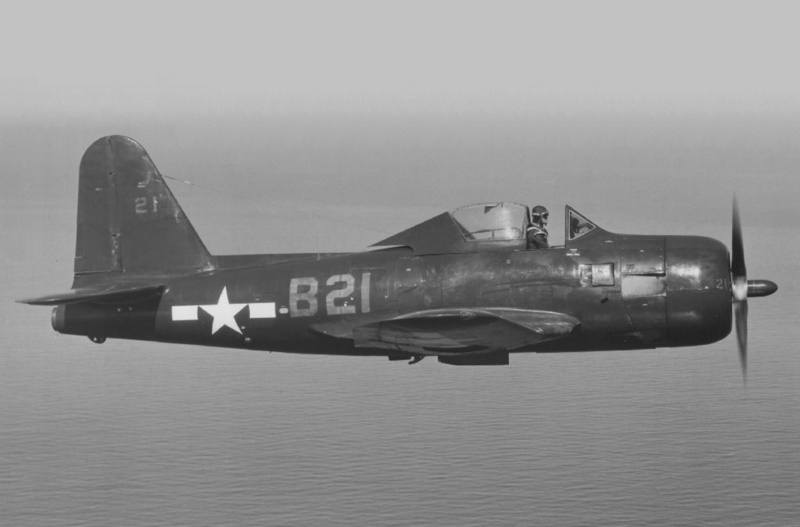
The Fireball had a conventional flight control surface arrangement, with one-piece slotted flaps, ailerons, rudder, elevators, and trim tabs. The prototypes had initially featured two-piece flaps; they also had smaller tail surfaces, which were rethought and increased in size to deal with yaw instability. It was armed with four 12.7-millimeter (0.50 caliber) M2 Browning machine guns, with 300 rounds per gun. Four 12.7-centimeter (5-inch) rockets could be carried under each outer wing panel; there was a hardpoint under each inner wing panel for a 380-liter (100 US gallon) drop tank, or a 450-kilogram (1,000-pound) bomb. There was armor protection in the cockpit, and for the oil cooler. The FR-1 featured a stinger-type arresting hook, somewhat unusually placed at the rear of the wings.
___________________________________________________________________
RYAN FR-1 FIREBALL:
___________________________________________________________________
wingspan:
12.19 meters (40 feet)
wing area:
25.5 sq_meters (275 sq_feet)
length:
9.86 meters (32 feet 4 inches)
height:
4.24 meters (13 feet 11 inches)
empty weight:
3,488 kilograms (7,689 pounds)
operating weight:
5,285 kilograms (11,652 pounds)
max speed:
650 KPH (405 MPH / 350 KT)
service ceiling:
13,100 meters (43,100 feet)
range with drop tanks:
2,610 kilometers (1,620 miles / 1,410 NMI)
___________________________________________________________________
All three prototypes were lost in crashes. Although 700 production FR-1s were ordered, only 66 were completed before the end of the war; it equipped one squadron, but they never saw combat. One FR-1 was converted to an "XFR-2" with a Wright R-1820-74W, providing 1,065 kW (1,425 HP), and there was talk of an "FR-3" with a GE I-20 turbojet -- but it was never built, and both these projects were canceled after the end of the war. In service, although the Fireball was remarkably agile, it proved to lack the strength needed for carrier operations, and was phased out in 1947.
* In the meantime, the Navy had been pursuing a Fireball variant with a turboprop instead of piston engine, which emerged in 1946 as the "XF2R-1 Dark Shark". The single prototype was a conversion of an FR-1, being fitted with a GE XT31-GE-2 turboprop with 1,680 ekW (2,250 eHP), driving a four-bladed Hamilton Standard propeller in an extended prop spinner. The new engine fit extended the length of the aircraft by 1.2 meters (4 feet), to 11 meters (36 feet 8 inches). A substantially larger tailfin fillet was added to deal with yaw instability. The added weight of the XT31 engine nulled out much of the advantage of the turboprop, and so the XF2R-1 was abandoned in 1947.
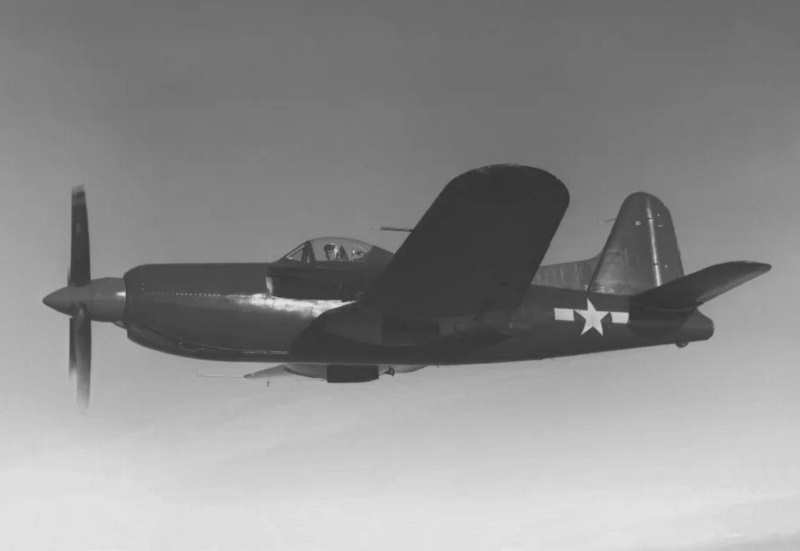
The USAAF, however, had been interested in the XF2R-1, and placed a contract for two examples of the "XF2R-2" -- which was to have the TG-100 turboprop and a Westinghouse J34 turbojet, with 18.7 kN (1,905 kgp / 4,200 lbf) thrust, as well as other features, such as a squared-off tail. The J34 was trialed in an FR-1, with the updated aircraft being designated the "XFR-4". The engine was longer, so the fuselage was stretched by 20 centimeters (8 inches); the inlets in the wingroots were eliminated, being moved to the fuselage forward of the cockpit, with the inlets shut by doors when the engine wasn't burning. The XFR-4 proved to be the fastest of the Fireballs, being about 160 KPH (100 MPH) faster than the FR-1, and in fact 40 KPH (25 MPH) faster than the XF2R-1.
The fading of interest in the mixed-power fighter configuration meant the XF2R-2 never flew. Most of the Fireballs were scrapped; only one has survived, as a static display.
* The Fireball wasn't the only Navy mixed-power fighter. In the spring of 1944, the Navy Bureau of Aeronautics (BuAer) awarded a contract to the Curtiss Aircraft Company for three prototypes of the "F15C" mixed-power fighter. Initial flight of the first "XF15C-1" prototype was on 27 February 1945, without the jet engine; that was installed in April. The first prototype crashed on a landing approach on 8 May 1945, but the second prototype was in the air in July; it was followed by the third prototype.

The XF15C-1 was of all-metal construction, with a low-mounted wing, tricycle landing gear, and a bubble canopy that slid back to open. The wings folded up for carrier storage. Other than the secondary jet engine -- fed by intakes in the wing roots -- it was distinctive in having a high tee tail, the tailfin featuring a large front fillet. Initially it had featured a conventional tailfin, without the fillet, but it seems the jet exhaust wasn't compatible with the low tailplane. Control surface arrangement was otherwise conventional.
The XF15C-1 was powered by:
The XF15C-1 was armed with four 20-millimeter cannon in the wings.
___________________________________________________________________
CURTISS XF15C-1:
___________________________________________________________________
length:
13.32 meters (43 feet 8 inches)
wingspan:
15 meters (48 feet)
wing area:
37 sq_meters (400 sq_feet)
height:
4.65 meters (15 feet 3 inches)
empty weight:
5,735 kilograms (12,650 pounds)
operating weight:
7,545 kilograms (16,630 pounds)
max take-off weight:
8,480 kilograms (18,698 pounds)
max speed:
755 KPH (470 MPH / 410 KT)
service ceiling:
12,700 meters (41,800 feet)
range:
2,230 kilometers (1,385 miles / 1,204 NMI)
___________________________________________________________________
Performance was excellent by piston standards, but the mixed-power fighter concept had no future, with the program being canceled in October 1945. One of the XF15C-1s has survived, and is now a museum piece.
BACK_TO_TOP* None of these aircraft are very well documented, so it ended up a scavenger hunt, sorting through aircraft encyclopedias, plus the online Wikipedia and other online sources.
* Illustrations credits:
* Revision history:
v1.0.0 / 01 nov 20 v1.0.1 / 01 aug 22 / Review & polish. v1.0.2 / 01 jul 24 / Review & polish. (+)BACK_TO_TOP
